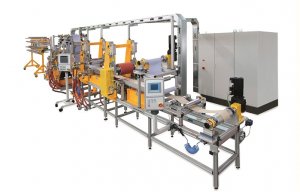
Roth invests in new lab plant for customer trials
2009 was a mixed year for the international knitting machinery market. Global deliveries to the world's mills increased in the case of single jersey and double jersey circular knitting machinery, but there was a fall in shipments of hand knitting and semi-automatic knitting machinery. There was also a decline in shipments of electronic flatbed knitting machinery. In the case of circular knitting, shipments of single jersey machinery rose by 3.5% while double jersey machinery del

25th October 2010
Innovation in Textiles
|
2009 was a mixed year for the international knitting machinery market. Global deliveries to the world's mills increased in the case of single jersey and double jersey circular knitting machinery, but there was a fall in shipments of hand knitting and semi-automatic knitting machinery. There was also a decline in shipments of electronic flatbed knitting machinery.
In the case of circular knitting, shipments of single jersey machinery rose by 3.5% while double jersey machinery deliveries increased by as much as 45.5%. In both cases, however, falls were witnessed in five regions - and in most cases the falls were at double digit rates. By contrast, shipments to mills in Africa soared at triple digit rates and the region became the second largest buyer in the case of single jersey and double jersey machinery. There was also a rise in shipments to mills in Asia but the region lost market share.
In terms of individual countries, shipments of single jersey and double jersey machinery to the industry in Mauritius surged - and the increase in shipments of single jersey machinery to this industry alone accounted for the entire increase in global deliveries.
There were also increases in shipments to the industries in several Asian industries - including China, Hong Kong, India, Indonesia, Iran, Malaysia, Syria and Vietnam. But there were double digit falls in deliveries to the industries in France, Germany, Italy, Japan, Morocco, Peru, Singapore, Taiwan, Turkey and the USA.
In flat knitting, global shipments of hand knitting and semi-automatic knitting machinery declined by 19.3%, while electronic flatbed machinery deliveries fell by 12.2%. In the case of hand knitting and semi-automatic flat knitting machinery, the drop was due almost entirely to a 44% plunge in shipments to mills in Bangladesh. However, there were also steep falls in shipments to several other industries, including most notably those in Hong Kong and South Korea.
By contrast, deliveries to Chinese mills increased by 162% and their share of the global total rose by 28 percentage points to 41%. But the largest buyer was the industry in Bangladesh with a 54% share of the market. In the electronic flatbed knitting machinery market, falls were witnessed in almost all regions, reflecting double digit declines in shipments to 21 of the 36 largest buying industries.
Nevertheless, strong growth was recorded in shipments to those in Bangladesh, Japan, Macau, Sri Lanka and Thailand. Shipments to the industry in China also rose and its share of the market increased from 44% to 60%.
Textiles Intelligence, Textile Outlook International
35 pages, published October 2010

Business intelligence for the fibre, textiles and apparel industries: technologies, innovations, markets, investments, trade policy, sourcing, strategy...
Find out more